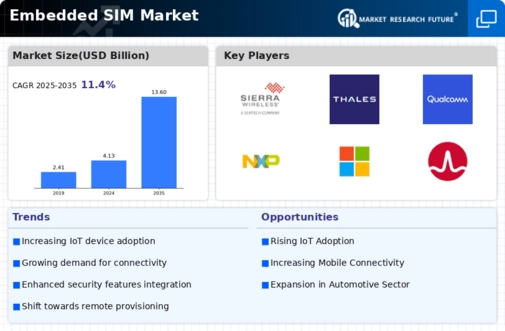With the proliferation of connected devices, there is a growing need for secure over-the-air management of mobile subscriptions. to develop innovative solutions that address the unique requirements of enterprises and consumers alike. Furthermore, as 5G networks expand globally, embedded SIM technology can facilitate improved network capabilities and user experiences, making it an attractive proposition for mobile network operators looking to differentiate their offerings. Recent trends indicate a shift towards standardization in the embedded SIM space, with major industry players collaborating to enhance interoperability across different platforms and networks.The standardization efforts are expected to bolster customer confidence and drive adoption rates.
Additionally, there is a noticeable increase in the implementation of eSIM technology in various sectors, including wearables and automotive applications, highlighting its versatility. As businesses and consumers increasingly prioritize connected lifestyles, the embedded SIM market is set to play a pivotal role in shaping the future of connectivity solutions across diverse applications and industries.
Embedded SIM Market Drivers
Growing Demand for IoT Devices
The expansion of the Internet of Things (IoT) ecosystem is a major driver for the Global Embedded SIM Market Industry. With the increasing reliance on connected devices ranging from smart home appliances to industrial machinery, the demand for reliable and efficient connectivity solutions has skyrocketed. Embedded SIMs (eSIMs) offer a seamless and flexible way to manage connectivity across various devices without the need for physical SIM cards, a feature that is especially important in rapidly evolving technological landscape. Additionally, eSIMs enable manufacturers to reduce size and design complexity while providing enhanced security features.
The versatility of embedded SIMs supports a wide array of use cases, from wearables to smart vehicles, driving further adoption across sectors such as healthcare, automotive, and smart city solutions. As companies seek to innovate and differentiate their offerings in the marketplace, the integration of eSIM technology becomes vital. This trend is expected to continue, propelling growth and investment in the Global Embedded SIM Market Industry and contributing to an increasingly connected world.
Moreover, the need for remote provisioning of mobile services is essential for IoT devices to ensure that they can connect to networks easily, which further supports the expansion of embedded SIM technology across different user segments. As the challenge of managing connectivity in a world with billions of devices continues, eSIMs are positioned as a crucial component for the next generation of IoT applications, enabling real-time communication and data exchange seamlessly.
Increased Focus on Remote Management
The shift towards remote management and deployment of connected devices is another significant driver for the growth of the Global Embedded SIM Market Industry. As organizations increasingly embrace remote work and operations, the ability to manage devices from a distance is crucial. eSIM technology allows for over-the-air updates and remote provisioning, simplifying the management of devices without physical intervention.
Regulatory Support for eSIM Adoption
Governments and industry bodies around the world are recognizing the potential of embedded SIM technology and are establishing regulations and standards to streamline its adoption. Such regulatory support a structured framework that encourages manufacturers and service providers to invest in eSIM solutions. This has a dual benefit: it not only fosters innovation growth among tech companies but also ensures that consumer protections and data privacy regulations are upheld.In turn, this drives the evolution of the Global Embedded SIM Market Industry, as stakeholders can navigate challenges with greater confidence and clarity.






















Leave a Comment